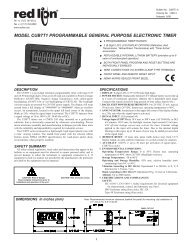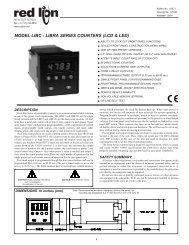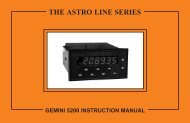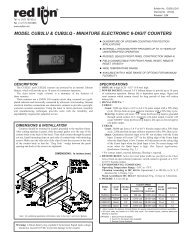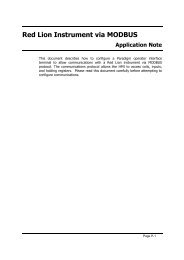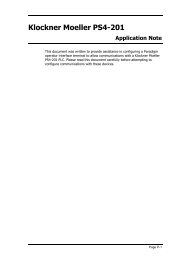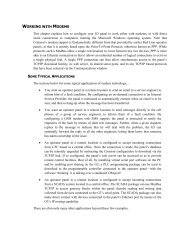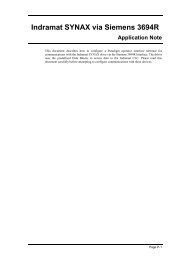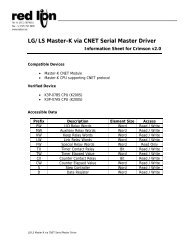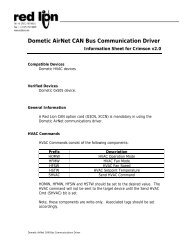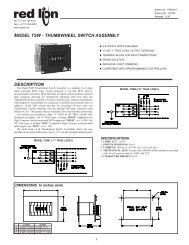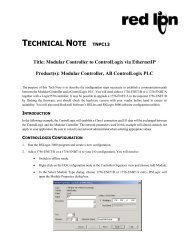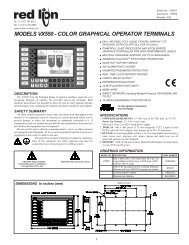PAXI PAXC PAXR Data Sheet/Manual PDF - Red Lion Controls
PAXI PAXC PAXR Data Sheet/Manual PDF - Red Lion Controls
PAXI PAXC PAXR Data Sheet/Manual PDF - Red Lion Controls
You also want an ePaper? Increase the reach of your titles
YUMPU automatically turns print PDFs into web optimized ePapers that Google loves.
Auto/<strong>Manual</strong> Mode Register (MMR) ID: U<br />
This register sets the controlling mode for the outputs. In Auto Mode (0) the<br />
meter controls the setpoint and analog output. In <strong>Manual</strong> Mode (1) the outputs<br />
are defined by the registers SOR and AOR. When transferring from auto mode<br />
to manual mode, the meter holds the last output value (until the register is<br />
changed by a write). Each output may be independently changed to auto or<br />
manual. In a write command string (VU), any character besides 0 or 1 in a field<br />
will not change the corresponding output mode.<br />
U abcde<br />
e = Analog Output<br />
d = SP4<br />
c = SP3<br />
b = SP2<br />
a = SP1<br />
Example: VU00011 places SP4 and Analog in manual.<br />
Analog Output Register (AOR) ID: W<br />
This register stores the present signal value of the analog output. The range<br />
of values of this register is 0 to 4095, which corresponds to the analog output<br />
range per the following chart:<br />
Register Value<br />
0<br />
1<br />
Output Signal*<br />
0-20 mA 4-20 mA<br />
0.000 4.000<br />
0.005 4.004<br />
0-10V<br />
0.000<br />
0.0025<br />
*Due to the absolute<br />
accuracy rating and<br />
resolution of the output<br />
card, the actual output<br />
signal may differ 0.15% FS<br />
2047 10.000 12.000 5.000 from the table values. The<br />
4094 19.995 19.996 9.9975 output signal corresponds<br />
4095 20.000 20.000 10.000 to the range selected (0-20<br />
mA, 4-20 mA or 0-10 V).<br />
26<br />
Writing to this register (VW) while the analog output is in the <strong>Manual</strong> Mode<br />
causes the output signal level to update immediately to the value sent. While in<br />
the Automatic Mode, this register may be written to, but it has no effect until the<br />
analog output is placed in the manual mode. When in the Automatic Mode, the<br />
meter controls the analog output signal level. Reading from this register (TW)<br />
will show the present value of the analog output signal.<br />
Example: VW2047 will result in an output of 10.000 mA, 12.000 mA or<br />
5.000V depending on the range selected.<br />
Setpoint Output Register (SOR) ID: X<br />
This register stores the states of the setpoint outputs. Reading from this<br />
register (TX) will show the present state of all the setpoint outputs. A “0” in the<br />
setpoint location means the output is off and a “1” means the output is on.<br />
X abcd<br />
d = SP4<br />
c = SP3<br />
b = SP2<br />
a = SP1<br />
In Automatic Mode, the meter controls the setpoint output state. In <strong>Manual</strong><br />
Mode, writing to this register (VX) will change the output state. Sending any<br />
character besides 0 or 1 in a field or if the corresponding output was not first in<br />
manual mode, the corresponding output value will not change. (It is not<br />
necessary to send least significant 0s.)<br />
Example: VX10 will result in output 1 on and output 2 off.<br />
COUNTER C SLAVE COMMUNICATIONS<br />
Counter C may be programmed for �����, to act as a serial slave display. By doing this, the carriage return <br />
is added as a valid command terminator character for all serial command strings. The as a terminator may be<br />
very useful for standard serial commands, even if Counter C is never displayed or sent a slave message. The $<br />
terminator should not be used in the slave mode. If numeric values are not to be saved to EPROM then send the value<br />
as a literal transmission with terminator.<br />
The Counter C slave display is right aligned. It has a capacity of displaying six characters. When less than six<br />
characters are received, blank spaces will be placed in front of the characters. If more than six characters are sent,<br />
then only the last six are displayed. The meter has a 192 character buffer for the slave display. If more than 192<br />
characters are sent, the additional characters are discarded until a terminator is received. Counter C processes<br />
numeric and literal transmissions differently.<br />
Numeric Transmissions<br />
When a string that does not begin with #, T, V, P or R is received, the meter<br />
processes it as a Numeric transmission. In this case, only the recognized numbers<br />
and punctuation are displayed. All other characters in the string are discarded. If<br />
a negative sign appears anywhere in the string the resulting number will be<br />
negative. Only the most significant decimal point is retained. If no numerical<br />
characters are received, then the numeric value will be zero. The numeric display<br />
can be used for setpoint (boundary action only) and analog output functions.<br />
When using this display for setpoint and analog output values, the decimal point<br />
position must match the programming entered through the front panel. The<br />
numeric value is retained in Counter C memory until another Numeric<br />
transmission is received.<br />
Recognized Numbers = 0, 1, 2, 3, 4, 5, 6, 7, 8, 9<br />
Recognized Punctuation = period, comma, minus<br />
Literal Transmissions<br />
When a string that begins with # is received, the meter processes it as a Literal<br />
transmission. In this case, any unrecognized characters will be replaced with a<br />
space. A Literal display will replace a Numeric value in the Counter C display.<br />
However, it will not remove a previous Numeric value from Counter C memory<br />
or prevent the Counter C outputs from functioning with the Numeric value.<br />
Literal transmissions are only possible when using RS232 or RS485 cards.<br />
Recognized Characters = a, b, c, d, e, f, g, h, i, j, l, n, o, p, q, r, s, t, u,<br />
y, z (in upper or lower case)<br />
Recognized Numbers = 0, 1, 2, 3, 4, 5, 6, 7, 8, 9<br />
Recognized Punctuation = period, comma, minus, blank



